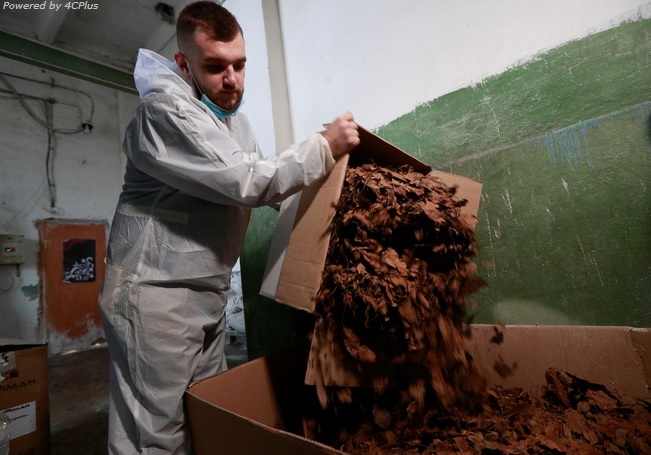What if I told you that the paper you use every day could come from fallen leaves instead of trees? Sounds wild, right? But that’s exactly what a Ukrainian startup called Releaf Paper is doing. In a world where we’re constantly hearing about climate change and deforestation, this company is flipping the script on paper production, and their story is both fascinating and inspiring.
Thank you for reading this post, don’t forget to subscribe!How It All Started: A School Experiment That Took Off
Let’s rewind a bit. The mastermind behind this whole thing is Valentyn Frechka, a teenager from Ukraine who, at just 16, stumbled upon something incredible. While most of us were trying to survive high school, he was busy experimenting in his school lab, looking for alternatives to traditional paper-making. One day, he realized that leaves – those same crunchy things you kick on your way to class – were packed with cellulose, the stuff you need to make paper. That was a game-changer.
Frechka didn’t just stop there. He spent months tweaking his process and making prototypes. By 2017, after a lot of trial and error (and probably a few late nights), he’d cracked it. He had developed a way to turn leaves into paper, and it wasn’t just some flimsy stuff that would tear at a glance. This was real, solid paper, good enough to rival the wood-pulp version we’ve been using for centuries.
From School Project to a Real Business
Fast forward a few years, and Releaf Paper is now a full-blown business. They’re not just talking the talk; they’re walking the walk. In 2021, with his co-founder Alexander Sobolenko, Frechka officially launched the company. They’ve already got a production capacity of 5,000 tonnes of paper a year. That’s a lot of paper, and they’re only getting started.
What’s even cooler? The paper they make isn’t just made from leaves, it’s made from leaves collected right in urban areas. Think parks, streets, anywhere that piles of leaves would otherwise just rot or get burned (which, by the way, releases a ton of harmful gases). So, they’re cleaning up cities and saving forests at the same time. Talk about a win-win!
How Do They Do It?
Okay, so you’re probably wondering how this all works. The process is surprisingly simple but super effective. First, they go around collecting all those fallen leaves that are just lying around. Instead of being a nuisance, these leaves become the raw material for something way more useful.
The leaves get cleaned up (because, let’s face it, city leaves can be gross), and then they’re stored and compressed so they can be used all year round. From there, the magic happens. The leaves go through a process where their cellulose fibers are extracted. That’s the key ingredient for making paper, and leaves are full of it.
Once they’ve got the fibers, they ship them off to paper mills where they’re turned into actual paper. Depending on what the customer needs, Releaf can make paper that’s entirely leaf-based or mix it with recycled paper or even virgin pulp. The end result? Paper that looks and feels just like the kind you’re used to, but with a much smaller environmental footprint.
You May Like This: SpaceX Crew Makes History with a Successful Return – Beroad
Why Should We Care? The Real Environmental Impact
Now, let’s talk about why this matters. We all know the paper industry is a bit of a problem when it comes to the environment. Every tonne of traditional paper costs about 17 trees. Seventeen! But with Releaf, that number drops to zero. Instead, they use about 2.3 tonnes of leaves to make one tonne of paper.
And get this: Releaf’s production process produces 79% less carbon dioxide than traditional paper-making. Even compared to recycled paper, they’ve managed to cut down emissions by 33%. Plus, they don’t need to use nasty chemicals like sulfur or chlorine, which are big offenders in the usual paper-making process. Less pollution, less waste, less energy. It’s a total game-changer.
Oh, and did I mention that Releaf Paper uses way less water? Traditional paper needs something like 230 cubic meters of water per tonne. Releaf? Just 10 to 15 cubic meters. That’s not a typo. It’s a fraction of the water usage, which is huge considering how much water is wasted every year in industrial processes.
It’s Not Just About Paper
What’s really cool about Releaf Paper is that they’re not just about making eco-friendly paper. They’re part of a bigger solution. Think about all those leaves clogging up drains and piling up in parks every autumn. Cities usually burn them, which is a massive waste and bad for the planet. Releaf is turning that problem into something positive by using those leaves for good.
Even better, their paper is 100% recyclable and biodegradable. In 30 to 40 days, it’s gone, broken down into the earth, leaving no trace. Imagine a world where the packaging you use is gone in a month without any harm to the environment. That’s what Releaf is offering. It’s a glimpse into a future where waste isn’t waste at all but a resource we can use again and again.
Where Are They Going Next?
Right now, Releaf Paper is based in Ukraine, but they’ve got big plans to expand. They’re already talking to potential partners in France, Japan, the US, and Canada. If everything goes to plan, you could see leaf-based paper coming to a store near you pretty soon.
And here’s the thing: Releaf’s founders aren’t just focused on making money (though of course, that’s part of it). They really want to change how we think about paper production. If they can reduce deforestation, cut emissions, and clean up urban areas all at the same time, why wouldn’t we jump on board?
The Future Looks Green
Releaf Paper is more than just an eco-friendly startup. They’re showing us that innovation doesn’t have to be complicated to make a big impact. By turning something as simple as leaves into paper, they’re tackling some of the biggest environmental problems of our time. And they’re doing it in a way that’s practical, scalable, and sustainable.
So next time you grab a piece of paper, think about where it came from. With any luck, one day soon, it’ll come from the leaves under your feet, not the trees in our forests.
Sources:
Why leaves are better than trees to produce the paper (releafbag.com)
This energy efficient technology turns fallen leaves into paper – Releaf Paper (releaf-paper.com)

